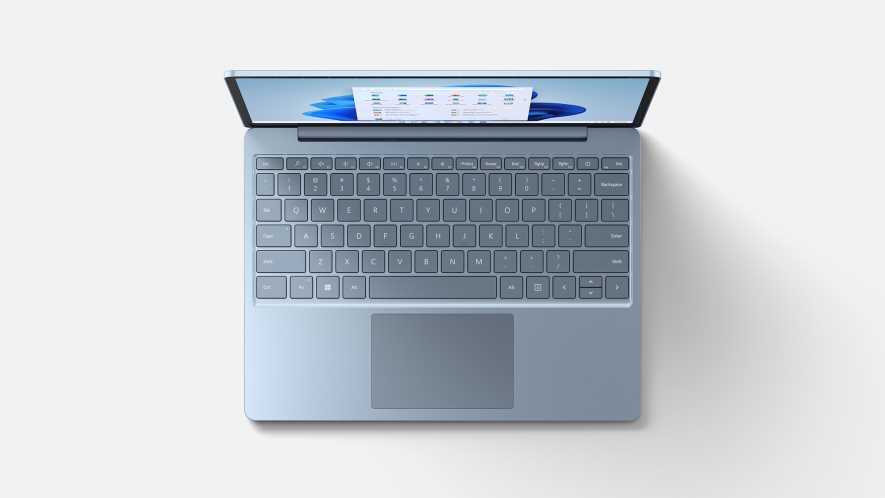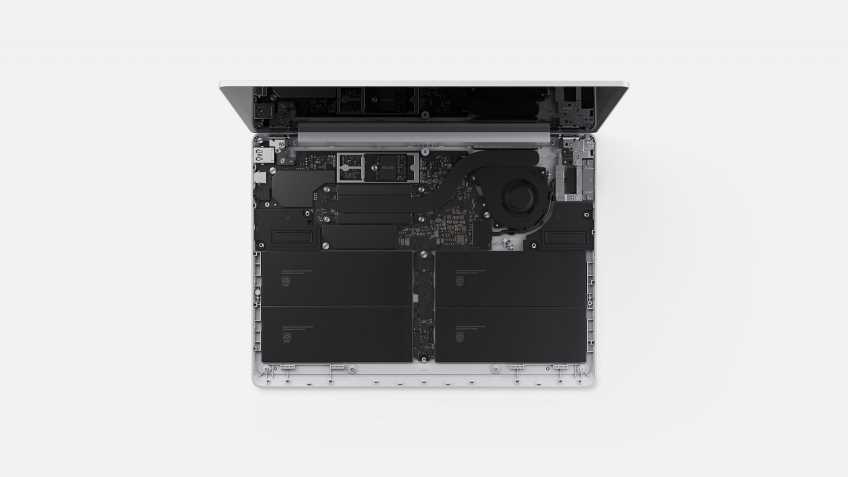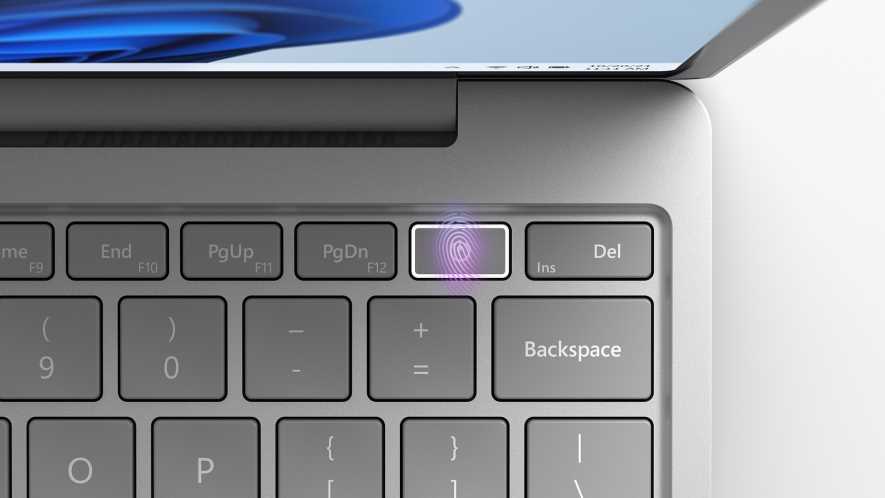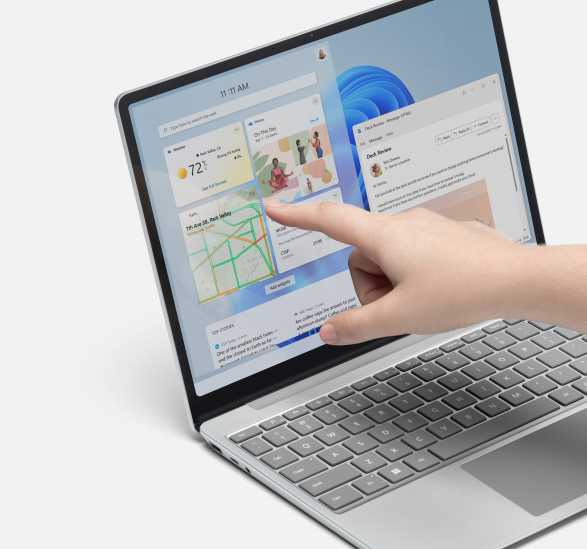* ThatSoftwareDude.com is a participant in the Amazon Services LLC Associates Program, an affiliate advertising program designed to provide a means for sites to earn advertising fees by advertising and linking to Amazon.com. It really does help keep the servers running!
Microsoft has recently released the follow up version to its small form-factor Surface Laptop Go line, the Surface Laptop Go 2. And for those confused by Microsoft's naming convention, the Surface Laptop Go 2 is not the Surface Go, or the Surface Laptop. It's the Surface Laptop Go. 2.
The Surface Laptop Go 2 is a 12.4 inch laptop built into a super lightweight chassis with a fingerprint reader, touchscreen and mid-tier processing power. It is the follow up the popular Surface Laptop Go and features a slew of improvements over its predecessor.
As a remote programmer, the Surface Laptop Go 2 has caught my eye. Because portability and decent power are near the top of my list in terms of priorities. Which is why I've been a big promoter of the Surface line for a few years now. You can read my thoughts on the Surface Pro 7 right over here. But how does the Surface Laptop Go 2 hold up to my day to day coding life? Well, much better than I would have guessed to be honest. So let's get into why.
Overview

Microsoft
If you have ever used a Surface device in the past, then you will notice 2 major things. For one, Microsoft has done a great job at making its Surface line feel incredibly premium at every price point. Even with its portable Go lines, you can tell that no corners were cut when designing the hardware itself. And that includes the material that they use as well, typically lightweight aluminum or magnesium, depending on the model.
And two, they are incredibly portable coming in under 13 inches and normally under 3lbs. Very few laptop manufacturers right are tackling the sub 13 inch market. But Microsoft has done so with both its Surface Pro line and now with the Surface Laptop Go.
And if you think that a 13.3 inch or a 14 inch screen laptop is close enough, you'd be off. I use a 14 inch ThinkPad ultrabook as my daily driver, and while it is one of the lightest laptops that Lenovo makes, it's noticeably heftier than the Surface laptops that I've used.
Well built construction in a light weight portable package sums up the Surface lines in a nutshell.
But the Laptop Go 2's standout feature, is essentially its price point. Because the base model comes in at just $599, and that includes an 11th gen i5 CPU and 128GB of SSD storage. Though you are giving up some features to account for that price.
Technical Specs

Microsoft
Here's the spec sheet for each of the configurations on the Surface Laptop Go 2:
| Dimensions |
10.95” x 8.12” x 0.62” (278.2mm x 206.2mm x 15.7mm)
|
| Display |
Screen: 12.4” PixelSense™ Display
Resolution: 1536 x 1024 (148 PPI)
Aspect ratio: 3:2
Touch: 10 point multi-touch
|
| Memory |
4GB or 8GB LPDDR4x RAM |
| Processor |
Quad Core 11th Gen Intel® Core™ i5-1135G7 Processor |
| Security |
Firmware TPM 2.0
Enterprise-grade protection with Windows Hello sign-in
One Touch sign in with Fingerprint Power Button (excluding i5/4/128)
|
| Software |
Windows 11 Home
Preloaded Microsoft 365 Apps
Microsoft 365 Family 1- month trial
Preloaded Xbox App
Xbox Game Pass Ultimate 1-month trial
|
| Sensors |
Ambient light sensor |
| What’s in the box |
Surface Laptop Go 2
39W Power Supply
Quick Start Guide
Safety and warranty documents |
| Weight |
2.48 lbs |
| Storage |
Removable3 drive (SSD) options: 128GB, 256GB |
| Battery life |
Up to 13.5 hours of typical device usage |
| Graphics |
Intel® Iris® Xe Graphics |
| Connections |
1 x USB-C®
1 x USB-A
3.5 mm headphone jack
1 x Surface Connect port |
| Cameras, video, and audio |
720p HD f2.0 camera (front-facing)
Dual far-field Studio Mics
Omnisonic Speakers with Dolby® Audio™ Premium |
| Wireless |
Wi-Fi 6: 802.11ax compatible
Bluetooth® Wireless 5.1 technology |
| Exterior |
Top: Aluminum
Base: Aluminum and polycarbonate composite resin system with glass fiber and 30% post-consumer recycled content.
Colors: Sage, Ice Blue, Sandstone, and Platinum |
| Keyboard layout |
Activation: Moving keys
Layout: QWERTY, full row of function keys (F1 – F12)
Windows key and dedicated buttons for media controls, screen brightness |
| Battery capacities |
Battery Capacity Nominal (WH): 41.0
Battery Capacity Min (WH): 40.0 |
Just by glancing at that list, you notice the biggest issue with the base model. And that's essentially that you are only getting 4GB of RAM for the entire unit, which at today's rate, is just not really that usable.
For comparison, my ThinkPad X1 Yoga takes up that much RAM just for the OS alone.
To really get your money's worth, you will want to go with any configuration above the base. Not only are you bumped up to 8GB of RAM (still not amazing, but functional), but you also get the added bonus of a fingerprint reader as well, which is a nice touch. But that upgrade will cost you an extra $100.
The highest spec model is pricey for what you are getting. The only real upgrade there is with the doubling of the storage drive. And in a world where 1TB SSD's can be scooped up for under $100 often times, it just doesn't really make sense to bump up to that premium level.
But overall, the middle configuration is really where you get your money's worth.
Performance

Microsoft
All models of the Surface Laptop Go 2 come equipped with 11th gen Intel i5 chips. As mentioned though, the base model only comes with 4GB of onboard RAM. And that's an issue, because in this day and age 8GB should be the bare minimum, especially if you are looking to actually use the laptop for more resource intensive work.
If you bump up to the i5, 8GB RAM and 128GB SSD model, you are looking at a relatively decent mid-tier laptop in terms of performance.
And while Microsoft could have gone with 12th gen Intel chips, I for one am glad that they stayed one generation behind. Because overall that helps to keep costs down.
At this mid-tier configuration though, the Surface Laptop Go 2 can pretty much handle any developers needs without a problem. These are the same specs that I personally have on my Surface Pro 6 and ThinkPad X1 Yoga, and each of those machines have handled everything that I have thrown at them, including:
- Visual Studio 2019
- VS Code
- SQL Server
- Node.js
- DBeaver
- Postgres
- Figma
- Asana
Essentially, my entire day of work can run just fine with the 8GB of RAM and 128GB configuration. I will mention now though, that I typically do use an external SSD drive for much of my work, so onboard storage isn't really a concern.
Your main limitation though, will be with RAM usage, as I typically live in the 85% to 95% range for the majority of the day. It generally takes a few hours of work before I begin needing to shut down applications to clear up space. And that's with the 8GB option.
While there is a rumored 16GB version of the Surface Laptop Go 2, it is offered as a business-only model.
As far as speed is concerned though, the Surface Laptop Go 2 is as quick as you are going to get with an i5 processor.
Things that in general just take a while, will continue to take a while here too. This is by no means an M1 or M2 competitor. But again, I don't think that it is trying to be.
Display

Microsoft
The Surface Laptop Go 2 features a 12.4 inch touchscreen with up to 300 nits and a resolution of 1536 x 1024. And while it would have been nice to see a full-HD display, I can safely say that at this screen size you can not tell the difference at all.
Pixels look crisp and overall brightness is decent enough for some work outdoors. Though in direct sunlight, at the max brightness, things will undoubtedly get washed out.
The bezels on the Surface Laptop Go 2 are relatively small when compared to some of its older siblings, and it really makes the tiny display look that much larger.
The aspect ratio for this model is 3:2, which is great for seeing more content on various apps. And in general, videos look very decent and you can't really spot the pixels by just looking.
And as with all of Microsoft's other Surface laptops, you also get a touchscreen display here. Which in general is very responsive. I typically don't use the touchscreen that often, but it's nice that it's there just in case.
Portability
This is where the Surface Laptop Go 2 really shines, and why you are probably reading this review. Because truth be told, nobody "needs" a 12.4 inch laptop that's sub FHD. You are here for the portability, and the hopeful performance.
And it doesn't disappoint. Because this thing is incredibly lightweight to the point that you can lift it up with one hand almost comfortably. And it's small enough to pretty much fit into any mid to normal sized backpack.
It's actually a pleasure to carry around with you. For one, it's metal aluminum finish is pretty premium and it indeed feels like it can handle any kind of tossing in your bag. And secondly, it's just thin enough that it pretty much feels as if you were just carrying around a notebook.
And so far, after a few weeks, putting the laptop in sleep mode does not seem to dramatically reduce the battery in any major way.
It almost feels like if you're using a premium tablet in a sense, where you can just close the lid and carry on with your day and check back a few days later and still have almost the same battery life.
Battery Life
Battery life is incredibly subjective and your personal workload will dictate just how good or how bad it will be.
Microsoft promises around 13 hours of battery on a full-charge here, but typically the tests being used to determine that revolve around playing videos on a loop, which most programmers don't do.
So far though, after hours and hours of usage, I can say that I am very impressed with battery life. I've been able to get a full 8 hours of work done without needing a charger, and that to me is the ideal portable battery life.
My overall estimates for my personal battery life needs, sits comfortably at around 9 hours of usage. And just for reference again, my ThinkPad X1 promises around 13-15 hours of battery life, but on heavy work days it last me around 4-5 hours.
Are there downsides?
The main downsides of the Surface Laptop Go 2 really come with the base model. The lack of fingerprint reader and the 4GB of RAM don't make this a competitor in this segment and particular price point.
At the mid-level spec configuration though, the main downsides are really the ones that other Surface laptops have, and that's with the limited number of ports. You are only getting 1 USB type C and 1 USB type A port here, which is perfectly fine if you plan on using the Surface Laptop Go 2 as a mobile workstation.
But also note that you aren't getting the highest resolution, brightest and crispiest display ever here. It's a standard (but nice) looking screen. And anything that helps to conserve battery life is a big win in my book.
But the one major downside that has been fixed (finally!) is the battery life, because so far this thing has lasted me the entire day, to the point where I'm no longer monitoring the battery every 2 hours like I used to it in the past.
Is it good for programming?
The answer to this question really depends on the kind of programming that you are looking to do. If you are looking to set up VS Code, Node.js and a local database, then you'll have no trouble at all with performance here. The i5 is plenty capable and with the 8GB RAM model, you'll do just fine.
But if you are a game developer, looking to render high res 3D models then you'll have to look elsewhere for that power. The graphics card here just won't do for that kind of workload.
As a reference though, I'm currently a full-time ReactJS developer working on a relatively hefty project, and so far I've had absolutely no issues in doing my work with the Surface Laptop Go 2.
Build times are fast and design tools like Figma load seamlessly. But more importantly for me, I can take the Surface Laptop Go 2 anywhere with me, to all of my meetings, and I can barely tell that it's there. And so far, I haven't had to look at the battery once.
So for me personally, this is the best balance of performance and mobility that I have found so far in a development laptop and I would highly recommend it for anyone looking for the same.